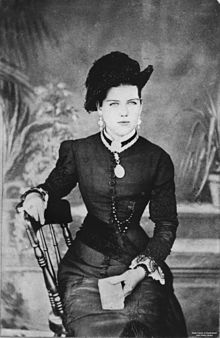Waist (garment)
In the 19th and early 20th centuries, the waistline was not only used to describe the narrowest part of the torso, but also the top of a two-piece women's dress. A waist is worked on the corsetted figure, fully lined and stiffened along the seams with whalebone or spring steel rods ( waist rods ) in order to hug the figure smoothly. Two fish-shaped darts that start under the chest, widen towards the waist and narrow again below, ensure a body-hugging fit, sometimes supported by a correspondingly curved front edge. In the case of a waist, the lining and outer fabric cut parts are processed together like one piece.
Depending on the prevailing fashion was waist level with the (body) waist straight or in a Schneppe end Fit far beyond the hip down range ( Küraßmode , 1880) or peplum have. The waists of day dresses could have a round neckline (before 1870), a small stand-up collar (around 1870–1900) or a stand-up collar (around 1900–1910), while the waists of evening, party and ball toilets cut more or less deep were.
In the 1890s, the developed blouses waist as a mix between the relatively loose fitting, unlined blouse and waist . Her lining was worked like a waist to figure, while the larger cut outer fabric was draped with the help of tucks and folds so that it looked as if the garment was loose. As a result, around 1897–1908, the front part of the waist could loosely bulge over the waistband of the skirt, while the lining was still tight on the corset .
The term waistline in the sense of a piece of clothing went largely out of use outside of costume studies in the 1920s.
literature
- Antonie Steimann. I Can Tailor - Illustrated House Book of Practical Tailoring . Ullstein & Co., Berlin / Vienna, 1908
- Hedwig Lechner and Gunda Beeg. The preparation of the women's wardrobe . Lipperheide, Berlin, 1886
- Heinrich Klemm. School of women's tailoring for thorough self-teaching . Dresden: Klemm, 1885

